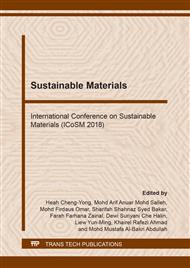p.115
p.121
p.127
p.134
p.142
p.151
p.157
p.163
p.169
Microwave and Electrical Properties of Zr-Doped SrTiO3 for Dielectric Resonator Antenna Application
Abstract:
Present investigation provides experimental studies on cylindrical dielectric resonator antennas (CDRAs) fabricated from SrTi1-xZrxO3 ceramic with different substitution of Zr in place of Ti for (0 ≤ x ≤1). Ceramic powder were prepared using conventional solid state reaction method. X-ray Diffraction exposes physical properties Zr-doped SrTiO3 which exhibit phase transition from cubic, tetragonal to orthorhombic phase. The electrical properties such as dielectric constant (εr) and dielectric loss (tan δ) were studied in variation of temperatures and frequencies. At room temperature the dielectric constant decreased from 240 to 21 with increase of Zr content however the amazing result was obtained for multiband antenna by Zr content. The dielectric loss obtain shows very low loss value roughly below 0.07 for all samples. The variations of return loss, resonance frequency and bandwidth of CDRAs at their respective resonant frequencies are studied experimentally.
Info:
Periodical:
Pages:
142-148
Citation:
Online since:
August 2018
Keywords:
Price:
Сopyright:
© 2018 Trans Tech Publications Ltd. All Rights Reserved
Share:
Citation:


